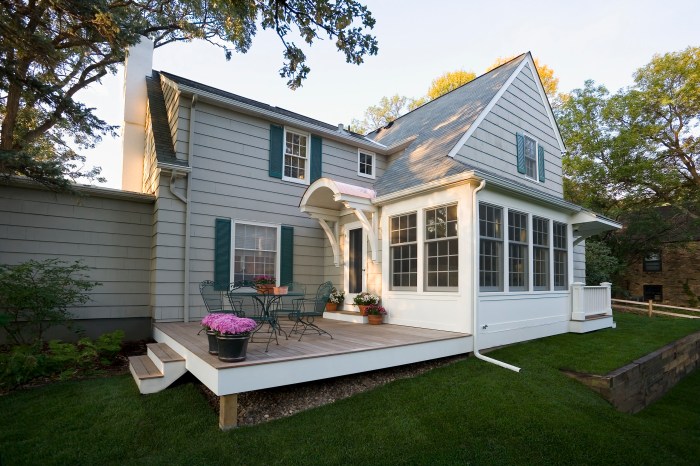Materials Used in 1940s Home Exteriors

1940s homes exterior design – The exterior materials used on 1940s homes reflect both the stylistic preferences of the era and the availability of building supplies, particularly in the post-World War II period. A combination of factors influenced the choices made, resulting in a diverse range of exterior finishes that still characterize many homes built during this decade.The post-war building boom significantly impacted material selection.
The war effort had disrupted supply chains and production, leading to shortages in some traditional materials. This, coupled with advancements in manufacturing techniques and the introduction of new materials, shaped the landscape of 1940s home exteriors. Consequently, architects and builders had to adapt and innovate, leading to a fascinating blend of familiar and novel materials in residential construction.
Common Building Materials, 1940s homes exterior design
Brick, wood siding, and stucco were the most prevalent materials used for 1940s home exteriors. Brick, a durable and classic choice, offered a sense of permanence and sophistication. Wood siding, particularly clapboard, provided a more rustic and traditional look, often seen in suburban developments. Stucco, a plaster-like material, offered a smooth, clean finish and was popular in warmer climates due to its insulating properties.
These materials often appeared in combinations, with brick foundations or accents complementing wood siding or stucco walls. Color palettes were often muted and earth-toned, reflecting a preference for understated elegance. Common colors included creams, tans, browns, and various shades of gray.
Asbestos Shingles
Asbestos cement shingles gained popularity in the 1940s, driven by their affordability, durability, and fire resistance. These shingles were typically gray or brownish-gray, providing a relatively uniform and somewhat textured appearance. While their longevity was a major selling point, the later discovery of the health risks associated with asbestos led to their eventual phasing out. Many homes built with asbestos shingles during this period still stand today, though their removal is often recommended due to potential health hazards.
The visual impact of asbestos shingles was one of understated simplicity, often contributing to the overall modest aesthetic of the homes they cladded.
Aluminum Siding
Aluminum siding emerged as a relatively new material option in the post-war era. Its lightweight nature, ease of installation, and low maintenance requirements made it attractive to builders, particularly in mass-produced housing developments. Aluminum siding came in a variety of colors, though muted tones like silver, beige, and various shades of green were common. Its smooth, metallic surface contrasted with the more textured finishes of brick and wood siding, giving homes a cleaner, more modern appearance.
The visual impact was one of a sleek, almost industrial feel, a departure from the more traditional aesthetics prevalent in earlier decades. While aluminum siding wasn’t as widely adopted as brick or wood, its use increased significantly during this period, representing a move towards more efficient and readily available building materials.
Landscaping and Exterior Details of 1940s Homes: 1940s Homes Exterior Design

The landscaping and exterior details of a 1940s home often reflect the prevailing aesthetic sensibilities of the era, blending practicality with a touch of formality. Careful consideration was given to creating a cohesive and welcoming exterior, showcasing both the home’s architectural style and the homeowner’s personal taste. These details, from the carefully chosen plants to the subtly elegant hardware, contribute significantly to the overall charm and character of these classic homes.
Landscaping in the 1940s often emphasized neatness and order. Lawns were meticulously maintained, reflecting the era’s focus on practicality and functionality. The choice of plants and their arrangement contributed to a sense of structured elegance, often mirroring the architectural lines of the house itself.
Typical 1940s Home Landscape Design
A typical 1940s landscape often featured a neatly mown lawn as the central element, framed by carefully arranged flowerbeds. These beds frequently showcased a mix of colorful annuals and perennials, chosen for their hardiness and ability to bloom throughout the growing season. Popular choices included roses, petunias, marigolds, and delphiniums, arranged in symmetrical or slightly asymmetrical patterns. Pathways, often made of brick or concrete, provided access to different areas of the yard, leading perhaps to a small patio or garden shed.
Fences, frequently made of wood, were typically simple and functional, sometimes featuring picket designs or a more rustic, split-rail style. The overall effect was one of controlled beauty, reflecting the era’s emphasis on order and practicality. Consider a Ranch style home, for instance, where the low-slung profile might be complemented by a sprawling lawn edged with neatly trimmed shrubs and a simple wooden fence.
Examples of Common Exterior Details
Exterior details on 1940s homes often showcased a blend of practicality and understated elegance. Light fixtures frequently featured simple, geometric designs, often in brass or chrome. These could range from understated wall sconces to more prominent porch lights, often with frosted glass globes. Door hardware typically featured simple, functional designs, with knobs and handles crafted from brass or polished chrome.
Mailboxes were often simple, often metal boxes mounted on sturdy posts, sometimes with a slightly curved top. These details, while seemingly minor, contributed significantly to the overall aesthetic of the home.
Landscaping Approaches Across Architectural Styles
The landscaping approach varied somewhat depending on the architectural style of the house. A Ranch-style home, with its low profile and emphasis on horizontal lines, might be complemented by a wide, open lawn with low-growing shrubs and a simple, functional fence. In contrast, a Cape Cod home, with its steeper roofline and more traditional styling, might feature a more formal garden with meticulously arranged flowerbeds and perhaps a more ornate fence.
The key difference often lies in the degree of formality; Ranch styles tended toward a more informal, relaxed landscaping, while Cape Cods often showcased a more structured and planned approach.
Landscaping Elements and Their Aesthetic Impact
The following elements contributed significantly to the overall aesthetic of a 1940s home’s exterior:
- Neatly mown lawn: Created a sense of order and cleanliness.
- Symmetrical or slightly asymmetrical flowerbeds: Provided pops of color and visual interest.
- Brick or concrete pathways: Offered functional access while adding a touch of formality.
- Simple wooden fences: Defined property lines and provided a sense of enclosure.
- Simple, geometric light fixtures: Added subtle elegance and functionality.
- Functional door hardware: Provided practicality while complementing the home’s style.
- Simple metal mailboxes: Offered a functional and understated element.
Clarifying Questions
What were some common colors used on 1940s homes?
Muted earth tones like greens, browns, and grays were popular, reflecting a connection to nature. Brighter colors were less common but could be found in details like trim.
How did the war affect the availability of building materials?
Wartime rationing limited the availability of certain materials, leading to substitutions and simpler designs. For instance, aluminum siding became more common due to wood shortages.
Were there any specific landscaping trends in the 1940s?
Landscaping often incorporated native plants and practical designs, reflecting a focus on low-maintenance options. Neat lawns and simple flowerbeds were common.




